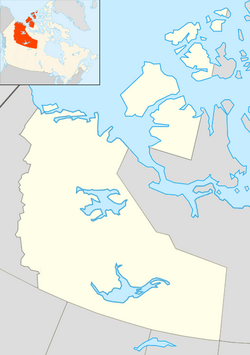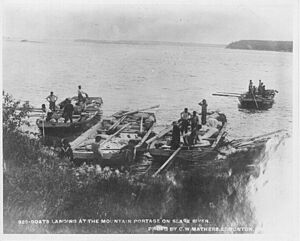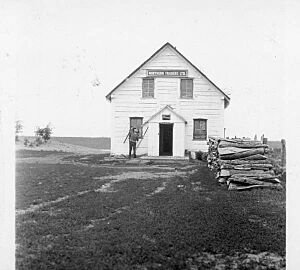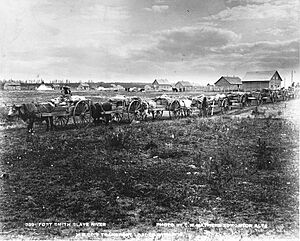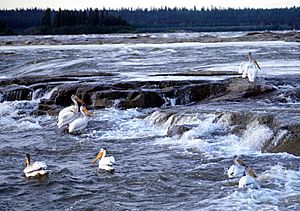Fort Smith, Northwest Territories facts for kids
Quick facts for kids
Fort Smith
Thebacha
|
|
|---|---|
|
Town
|
|
 |
|
| Motto(s):
Perseverance
|
|
| Country | Canada |
| Territory | Northwest Territories |
| Region | South Slave Region |
| Constituency | Thebacha |
| Census division | Region 5 |
| Town | 1 October 1966 |
| Area | |
| • Land | 24.6 km2 (9.5 sq mi) |
| • Population Centre | 2.04 km2 (0.79 sq mi) |
| Elevation | 205 m (673 ft) |
| Population
(2021)
|
|
| • Total | 2,248 |
| • Density | 91.21/km2 (236.2/sq mi) |
| • Population Centre | 1,749 |
| • Population Centre density | 855.8/km2 (2,217/sq mi) |
| Time zone | UTC−07:00 (MST) |
| • Summer (DST) | UTC−06:00 (MDT) |
| Postal code |
X0E 0P0
|
| Area code(s) | 867 |
| Telephone Exchange | 872 621 870 |
| GNBC Code | LAILN |
| - Living cost (2018) | 132.5 |
| - Food price index (2019) | 118.8 |
| Climate | Dfc |
| NTS Map | 75D4 Fort Smith |
| Sources: Department of Municipal and Community Affairs, Prince of Wales Northern Heritage Centre, Canada Flight Supplement 2018 figure based on Edmonton = 100 2019 figure based on Yellowknife = 100 |
|
Fort Smith is a town in Canada's Northwest Territories (NWT). Its name in the Chipewyan language, Thebacha, means "beside the rapids." This town is in the southeastern NWT, right on the Slave River. It's also very close to the border with Alberta.
Contents
Fort Smith's History
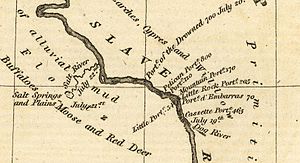
Fort Smith grew up around the Slave River. This river was a super important link for water travel. It connected southern Canada to the western Arctic. Early fur traders found a special route called a portage here. A portage is a path where people carry boats and goods over land to avoid dangerous parts of a river.
Indigenous peoples had used this portage for hundreds of years. It helped them get around four sets of very dangerous rapids. These rapids were so risky that one section became known as 'The Rapids of the Drowned'.
Early Indigenous Peoples
The groups of Indigenous people living in the area changed over time. By 1870, the Slavey people had moved north. The Cree people then lived in the Slave River Valley. The Chipewyan people also started moving into this region.
Fur Trade and New Posts
Peter Pond was the first non-Indigenous trader to travel the Slave River. He met Indigenous peoples here in the 1780s. He set up a trading post called Fort Chipewyan on Lake Athabasca.
The Hudson's Bay Company became very active in the fur trade. They used special boats called York boats on the Slave River. Sometimes, they had to use small portages to get past the most dangerous rapids.
In 1872, the Hudson's Bay Company built an outpost. It was called Smith's Landing, now known as Fort Fitzgerald. This was at the southern end of the Slave River rapids. In 1874, they built another outpost at the northern end of the rapids. This one was named Fort Smith. Both places were named after Donald Alexander Smith.
Growing as a Community
In 1876, the Roman Catholic Mission moved to Fort Smith. The community was growing and doing well.
In the late 1800s, steamboats started to be used on the rivers. The SS Wrigley and SS Grahame helped move goods.
The Klondike Gold Rush in 1898 brought many gold seekers through Fort Smith. They used the portages and bought supplies here.
In 1911, the Canadian government set up offices in Fort Smith. They sent an Indian agent and a doctor. The Royal Northwest Mounted Police also opened a station. This made Fort Smith an important center for transportation and government in the western Arctic.
Important Buildings and Services
The mission built the first hospital, St. Anne's, in 1914. They also built the first school in 1915. The Roman Catholic Mission had a farm called St. Bruno's Farm. It provided food like vegetables, meat, and dairy products. The farm even had over 140 cattle!
In 1919, horse-drawn freight services were joined by tractors. These powerful machines helped haul heavy goods over the portage.
When oil was found at Norman Wells in 1920, Fort Smith grew even more. A new government building was built. The first bank in the Northwest Territories opened here in 1921.
By the 1930s, building ships and barges was a big part of Fort Smith's economy. The Hudson's Bay Company and Northern Transportation Company Limited (NTCL) built shipyards here.
Wood Buffalo National Park was created in 1922. Its main offices are in Fort Smith.
In 1924, Fort Smith got its first radio system. In 1928, the Fort Smith Airport was built.
World War II and Growth
The discovery of gold in Yellowknife in 1938 gave Fort Smith another boost. Many gold prospectors passed through and bought supplies.
During World War II (1942–1943), Fort Smith played a small role. About 2,000 United States Army soldiers came through. They were on their way to the Canol Oil Pipeline Project. They brought many supplies. To move these, they built a tractor road from Fort Smith to Hay River.
After 1945, Fort Smith's population grew five times bigger. More government offices were added. The town became a major transportation hub for the Mackenzie District.
Becoming a Town
Fort Smith officially became a village in 1964. Two years later, on October 1, 1966, it became a town. The all-weather road to Hay River was finished in 1966. This connected Fort Smith to the south all year round.
However, a new rail link to Hay River in 1964 changed things. Fort Smith was no longer the main transportation hub. Shipping on the Slave River stopped in 1968.
In 1967, Yellowknife became the capital of the Northwest Territories. But Fort Smith remained an important administrative center for the government.
A Landslide and New Beginnings
On August 9, 1968, a large landslide happened. A big piece of the riverbank broke away. It damaged property and sadly, one person died. Since then, the riverbank has been made safer. It's now a gentle hillside called Riverbank Park. It has trails, picnic areas, and a viewing spot for the Rapids of the Drowned.
In 1970, an Adult Vocational Training Centre opened. It later became Thebacha College in 1981. This college eventually changed its name to Aurora College in 1995.
Today, Fort Smith's economy relies on government jobs, education, and tourism. There's also interest in bringing back the portage route to help supply the Athabasca oil sands by river.
Fort Smith's Geography
Fort Smith is about 300 kilometers (186 miles) southeast of Yellowknife. Yellowknife is the capital of the Northwest Territories. The main office for Wood Buffalo National Park is located in Fort Smith. Also, the largest campus of Aurora College, called Thebacha Campus, is here.
Fort Smith is part of the South Slave Region. You can reach Fort Smith all year by using the Fort Smith Highway. In winter, there's a special winter road that connects Fort Smith to Fort Chipewyan. From there, you can get to Fort McMurray. There's also an all-weather road called Pine Lake Road that links to Fitzgerald.
Climate in Fort Smith
Fort Smith has a dry subarctic climate. This means it has very long, cold winters. The summers are warm but quite short.
The hottest temperature ever recorded in Fort Smith was 39.9°C (103.8°F) on June 30, 2021. The coldest temperature ever recorded was -57.2°C (-71.0°F) on December 26, 1917. These are the hottest and coldest temperatures ever recorded in the Northwest Territories!
| Climate data for Fort Smith (Fort Smith Airport) WMO ID: 71934; coordinates 60°01′13″N 111°57′43″W / 60.02028°N 111.96194°W; elevation: 205.1 m (673 ft); 1981−2010 normals, extremes 1913−present |
|||||||||||||
|---|---|---|---|---|---|---|---|---|---|---|---|---|---|
| Month | Jan | Feb | Mar | Apr | May | Jun | Jul | Aug | Sep | Oct | Nov | Dec | Year |
| Record high humidex | 8.4 | 11.6 | 13.9 | 29.6 | 32.7 | 40.6 | 41.7 | 38.5 | 31.3 | 25.9 | 12.1 | 8.9 | 41.7 |
| Record high °C (°F) | 8.7 (47.7) |
12.2 (54.0) |
15.0 (59.0) |
30.0 (86.0) |
31.8 (89.2) |
39.9 (103.8) |
39.4 (102.9) |
35.3 (95.5) |
31.7 (89.1) |
26.7 (80.1) |
13.3 (55.9) |
9.4 (48.9) |
39.9 (103.8) |
| Mean daily maximum °C (°F) | −17.8 (0.0) |
−13.5 (7.7) |
−5.0 (23.0) |
6.0 (42.8) |
14.2 (57.6) |
20.9 (69.6) |
23.3 (73.9) |
20.8 (69.4) |
13.6 (56.5) |
4.2 (39.6) |
−7.6 (18.3) |
−15.0 (5.0) |
3.7 (38.7) |
| Daily mean °C (°F) | −22.4 (−8.3) |
−19.1 (−2.4) |
−11.8 (10.8) |
−0.3 (31.5) |
7.8 (46.0) |
14.4 (57.9) |
17.0 (62.6) |
14.7 (58.5) |
8.4 (47.1) |
0.2 (32.4) |
−11.4 (11.5) |
−19.3 (−2.7) |
−1.8 (28.8) |
| Mean daily minimum °C (°F) | −27.0 (−16.6) |
−24.7 (−12.5) |
−18.5 (−1.3) |
−6.6 (20.1) |
1.3 (34.3) |
7.9 (46.2) |
10.7 (51.3) |
8.6 (47.5) |
3.1 (37.6) |
−3.7 (25.3) |
−15.1 (4.8) |
−23.5 (−10.3) |
−7.3 (18.9) |
| Record low °C (°F) | −53.3 (−63.9) |
−55.0 (−67.0) |
−48.3 (−54.9) |
−40.6 (−41.1) |
−23.0 (−9.4) |
−7.2 (19.0) |
−4.4 (24.1) |
−6.1 (21.0) |
−15.0 (5.0) |
−31.1 (−24.0) |
−42.8 (−45.0) |
−57.2 (−71.0) |
−57.2 (−71.0) |
| Record low wind chill | −60.4 | −58.4 | −55.7 | −50.4 | −26.2 | −8.0 | 0.0 | −4.7 | −17.8 | −35.3 | −48.8 | −59.6 | −60.4 |
| Average precipitation mm (inches) | 16.5 (0.65) |
12.2 (0.48) |
13.2 (0.52) |
12.7 (0.50) |
27.8 (1.09) |
48.8 (1.92) |
54.5 (2.15) |
54.5 (2.15) |
42.4 (1.67) |
32.4 (1.28) |
22.3 (0.88) |
16.6 (0.65) |
353.6 (13.92) |
| Average rainfall mm (inches) | 0.1 (0.00) |
0.1 (0.00) |
0.3 (0.01) |
6.2 (0.24) |
22.6 (0.89) |
48.7 (1.92) |
54.5 (2.15) |
54.3 (2.14) |
41.6 (1.64) |
14.0 (0.55) |
1.5 (0.06) |
0.3 (0.01) |
244.3 (9.62) |
| Average snowfall cm (inches) | 24.0 (9.4) |
18.7 (7.4) |
17.5 (6.9) |
7.8 (3.1) |
5.7 (2.2) |
0.0 (0.0) |
0.0 (0.0) |
0.2 (0.1) |
1.0 (0.4) |
21.5 (8.5) |
30.1 (11.9) |
23.8 (9.4) |
150.2 (59.1) |
| Average precipitation days (≥ 0.2 mm) | 10.8 | 8.6 | 7.9 | 5.8 | 8.5 | 10.9 | 11.8 | 12.6 | 12.1 | 13.7 | 13.5 | 11.6 | 127.7 |
| Average rainy days (≥ 0.2 mm) | 0.2 | 0.2 | 0.4 | 2.8 | 7.4 | 10.9 | 11.8 | 12.6 | 11.7 | 7.5 | 1.2 | 0.3 | 66.9 |
| Average snowy days (≥ 0.2 cm) | 12.3 | 10.1 | 8.6 | 3.7 | 1.8 | 0.0 | 0.0 | 0.1 | 0.8 | 8.4 | 14.7 | 13.3 | 73.9 |
| Average relative humidity (%) | 79.8 | 77.6 | 67.1 | 51.4 | 42.3 | 43.8 | 48.2 | 52.8 | 58.0 | 71.4 | 83.8 | 82.0 | 63.2 |
| Mean monthly sunshine hours | 57.1 | 113.7 | 176.7 | 243.0 | 285.9 | 299.1 | 301.0 | 261.7 | 132.0 | 87.3 | 43.5 | 28.3 | 2,029.3 |
| Source: Environment and Climate Change Canada (sun 1951–1980) | |||||||||||||
People of Fort Smith
In the 2021 Census, Fort Smith had a population of 2,248 people.
Who Lives in Fort Smith?
According to the 2016 census, most people in Fort Smith are Indigenous. This includes 920 First Nations people, 585 Métis people, and 135 Inuit people.
Languages Spoken
The main languages spoken in Fort Smith are English, Chipewyan (also called Dene), Cree, Dogrib (Tłı̨chǫ), Slavey-Hare, Inuinnaqtun (Inuvialuktun), and Inuktitut.
Fun Things to Do in Fort Smith
Fort Smith is home to the Northern Life Museum. You can also visit the museum ship Radium King there. You can also get to Wood Buffalo National Park from Fort Smith.
Every August, Fort Smith hosts the South Slave Friendship Festival. This is a music and arts festival. Musicians and artists from all over the Northwest Territories come to share their talents.
Many tourists visit to see the amazing Slave River. Kayakers love to try out its rapids.
Fort Smith Mission Park is a popular spot. It has old historic buildings and a grotto from the Oblate Catholic Mission.
In the summer, you can see pelicans nesting on the rapids near Fort Smith. Whooping cranes, which are an endangered species, also nest here. You can see them from special air tours, but you can't go to their nesting areas on the ground.
Education in Fort Smith
Fort Smith has several schools and colleges. These include Joseph Burr Tyrrell Elementary School and Paul William Kaeser High School. The Thebacha Campus of Aurora College is also located here. The main office for the South Slave Divisional Education Council is in Fort Smith too.
Famous People from Fort Smith
Mark Carney, who used to be the head of both the Bank of England and the Bank of Canada, was born in Fort Smith.
Images for kids


